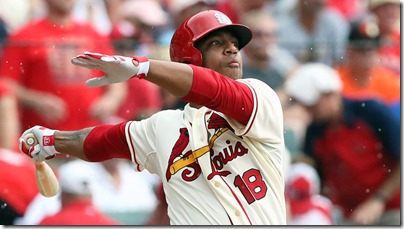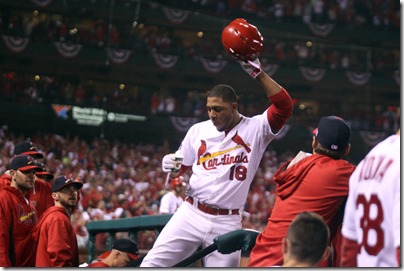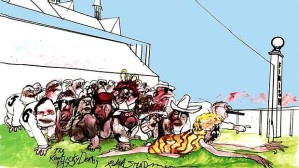Blog Archives
Some Thoughts on Joe Strauss
St. Louis Post-Dispatch sportswriter Joe Strauss died over the weekend at the age of 54 after battling leukemia for the better part of a year. He left an indelible mark on St. Louis sports in his 13+ years there, and obituaries and tributes have poured in from all over the sports world in the less than 24 hours since the announcement of his passing.
Strauss was a great writer who cultivated a persona on social media and other places online as a snarky contrarian who enjoyed pouring gasoline on the already enflamed fringes of any local fan base. But those who truly knew him confirm what most of us suspected: he wasn’t some joyless curmudgeon; he had a huge heart and was loved and respected even beyond his professional accomplishments.
I had the privilege of sharing the journalistic floor with Joe a couple of times. He pursued answers relentlessly. And, while amusing in the moment, the exasperation on his face when a question was blown off, answered weakly, or stepped on by someone else’s softball told a story of a man who took great pride and responsibility in his work. For me—a credentialed blogger trying to do a good job but still not step on the toes of the real pros—he was inspiring.
I also had the privilege of talking with him a bit in that arena. While writing up his story after most had gone home, he took the time to have a conversation with me about sports writing—something most bloggers, I’m sure, would find unbelievable if they’ve followed his Twitter account over the years. But there was no “Who are you? Why are you here? Don’t bother me; I’m working” coming from him, even in the face of trying to complete his work. It was a short conversation, but it’s one I wish I’d kept my recorder running for.
In the wake of Strauss’s passing, a recurring theme emerged online yesterday. It contained some form of “I didn’t always agree with/like/want to hear what he said, but he was a great writer…” As his name trended on Twitter, I couldn’t help but wonder what he would think of that if he knew about it…a “balloon party” in his honor. For all the battles he fought—and sometimes initiated—with readers in St. Louis, I hope he knew just how much people really enjoyed his work. I hope he knew how respected he was as a journalist by peers and readers alike. And I hope he knew what a vacancy he would leave behind.
Rest in peace, Joe Strauss. Thank you for always giving it to us straight.
–CCR
Jason Heyward and Deja Vu
Remember that time the St. Louis Cardinals handed out one of the richest contracts in baseball for a player who was just OK offensively but was an elite defender at his position? No, this is not breaking news about the signing of Jason Heyward. This is a statement that signing him for $20 million or more per year for a period of eight or more years isn’t really a bad idea.
…unless you also would have passed on the signing of Ozzie Smith in 1985.
I can hear the laughter…I can feel the eyes rolling…and I can sense the windows about to be clicked close, so first let me get the caveats out there:
- Jason Heyward is not Ozzie Smith, and I don’t mean to imply that he is or ever will be.
- Ozzie Smith signed his contract before his age-30 season as a seven-year veteran; Heyward will sign his next contract before his age-26 season as a six-year veteran.
- Being an elite outfielder and being the best defensive shortstop (player?) the game has ever seen are not even close to the same thing, and I know that.
- The game–and the player traits/talents valued within it–are vastly different today than they were 30 years ago.
With all that out of the way, here’s what I am saying: there is precedent for the Cardinals handing out what is an outlandish (for the era) contract to an elite defender with a questionable bat. And they really ought to go back to that well one more time.
I’m not what they call “smart” when it comes to advanced math, but I do understand its place in the game. For a deeper dive on the statistics side, take a look at this article from the SABR site about Ozzie being worth his “outlandish” contract–all $2.2 million per year of it–and then take a look at this article on Fangraphs about Jason Heyward’s contract outlook in free agency. Both are telling with regard to just how much player salaries have spiked over the years, but they also indicate the value those salaries covered or will cover.
And I know that’s pretty heady stuff. I also know there is value, both real and perceived, in the counting stats like batting average, home runs, RBI, etc. So age differences aside, here’s a quick comparison of “baseball card stats” for The Wizard and J-Hey through the first six seasons of their respective careers:
Smith – 3,729 PA: .235/.306/.293, 6 HR, 222 RBI, 206 SB, 959 TB
Heyward – 3,429 PA: .268/.353/.431, 97 HR, 352 RBI, 86 SB, 1,295 TB
It’s not close: Jason Heyward is a superior hitter to Ozzie Smith. And frankly, so were most hitters throughout history, as well as nearly every Hall of Famer before him or since. It’s no secret Smith’s value was almost exclusively about his defense. I mean, aside from the iconic 1985 NLCS home run, pretty good (for the era) stolen base totals, and the outstanding MVP runner-up campaign he put together in 1987–the only season in which his batting average topped .300, but also in which he hit zero (!) home runs–Ozzie Smith was a pretty pedestrian hitter. And yet he made more money per year on this deal than contemporary and fellow Hall of Famer Eddie Murray, who was a perennial Top-10 in homers, RBI, batting average, OPS, etc.
This was not some crazy oversight at the time, either. Check out this article from the LA Times about Ozzie’s contract extension, and this article from the NY Times during the stretch run of that season. It’s hard to imagine now with the advantage of hindsight, but giving him that contract was a pretty big deal and not everyone was on board.
The reason, of course, is that at the time Ozzie Smith was recognized as an all-world defender but, offensively, not worth the dollars he was commanding. Sound familiar?
There are a dozen MLB players who have signed contracts of $200 million or more, and more than 40 who have earned $20 million per year or more. Now we can debate the theory of whether those dollar amounts are outlandish or a 10 year contract is absurd. I’m not saying anyone is crazy if they are against 10-year, $200+ million contracts as a matter of principle. But this is the current climate in which MLB operates. And with these new billion dollar TV deals kicking in all around the league, it’s not like these numbers will regress going forward. The Cardinals already have such a deal in place, so money really is no object here. And with Heyward being only 26, years really shouldn’t be either.
Comparing Jason Heyward and Ozzie Smith as players may approach comparing apples and oranges, but let’s not pretend giving Heyward a huge contract would be franchise-crippling or somehow stupid because he won’t ever lead the league in homers and RBI. Run prevention can lead to success, too; just ask the 100-win, 3.99-runs-per-game 2015 Cardinals. There are other options on the free agent market, and the Cards certainly could find ways to win with other guys. But they can also find exceptional, possibly franchise-altering value in a guy that doesn’t yank one over the wall 30 times every year. They’ve done it before.
–Chris
I’ll Miss Jon Jay, but…
…I’m not sad he’s gone.
The Cardinals shipped Jay to the San Diego Padres for Jedd Gyorko and cash. It was a necessary move, even if an unpopular one for some.
I like Jon Jay. He made some great catches, scored some big runs, and occasionally has awesome hair. He remains one of the faces of that glorious 2011 World Series run. But I get why it was time to move him. The minuses–terrible arm, not very good speed, no power at the plate, recovering from injury, in his walk year, wrong side of 30–simply outweigh the pluses. And if the Cardinals do absolutely nothing else this offseason, he would still only be the fifth best outfielder on the roster behind Randal Grichuk, Stephen Piscotty, Matt Holliday, and Tommy Pham.
That’s an important point to remember: a LOT of things would have to break his way for Jon Jay to be a starter on the 2016 St. Louis Cardinals. In San Diego, he has a much better shot at more playing time; he may even be their Opening Day leadoff hitter. But the chances of that happening wearing the Birds on the Bat fell somewhere between slim and none. Jay is an OK fielder with a rag arm and a wet newspaper bat. It’s unfortunate, especially since he was injured for a large part of 2015. But even if he played to his averages–.287/.354/.384, 6 HR, 50-ish RBI, 104 OPS+–who sits while he plays? Holliday? Grichuk? Piscotty?
Th is move is part of a grand overhaul of the bench–which the Cardinals sorely needed–that began in the middle of the 2015 season with the acquisition of Brandon Moss. They may have had solid defensive replacements in Peter Bourjos, Pete Kozma, Tony Cruz, and even Jay to an extent. But they’re likely to get more offense from Moss, Gyorko, Pham, and Brayan Pena.
is move is part of a grand overhaul of the bench–which the Cardinals sorely needed–that began in the middle of the 2015 season with the acquisition of Brandon Moss. They may have had solid defensive replacements in Peter Bourjos, Pete Kozma, Tony Cruz, and even Jay to an extent. But they’re likely to get more offense from Moss, Gyorko, Pham, and Brayan Pena.
At least that’s the hope. In Gyorko, the Cards get a middle infielder with some pop at the plate. He’s not a world-beater offensively OR defensively, but he’s got some upside the recent alternatives simply didn’t. And the Cardinals had to find someone who could spell Jhonny Peralta and platoon with Kolten Wong, which could help both have better seasons in 2016.
And stay tuned for more. With the loss of Lance Lynn for the season to go with the injury question marks already surrounding the rest of the rotation, they will still look for a starting pitcher. Maybe a trade completely upends things on what projects to be the Opening Day starting lineup. Maybe they still re-sign Jason Heyward and shuffle the deck at first base even more. But I certainly don’t think this trade is the only thing John Mozeliak does to the roster this offseason.
Bottom line: the Cardinals needed more power from their bench, and Jon Jay was the odd man out. I sincerely hope he fully recovers from his injury and has a great year as a starting outfielder in San Diego. At the very least, he needs to be healthy in mid-July when the Padres visit Busch Stadium so he can collect his requisite Sea of Red standing ovation.
My Greatest Baseball Day
Four years ago today, I was going on about four hours of fitful sleep. The night before, I and the rest of the baseball world witnessed one of the greatest games in the history of the World Series. After that game, I was so wired, so geeked I couldn’t fall asleep at all. Finally, after pounding out a delirious blog post, I managed to nod off…only to sit bolt upright the instant my alarm went off a few hours later, feeling as awake and alive as I ever have in my life. I ran into the other room to look at the two most exciting pieces of paper I think I’ve ever held.
I’m sure I managed to be productive at work that Friday, but I couldn’t tell you how. All I wanted to do was go to Busch Stadium, even hours before the game was supposed to start. I wanted to sit in my bleacher seat with a beer and 45,000 or so of my closest friends to watch Game 7 of the World Series. Even just saying the phrase “Game 7 of the World Series” gives me chills as a baseball fan; as a Cardinals fan about to walk into Busch Stadium to watch it live I was almost unable to process the sights…the sounds…the feeling.
None of us knew it at the time, of course, but a fan favorite (certainly one of mine) from the Whiteyball Era made his final appearance before Cardinal Nation and passed less than a week later.
After the previous night’s heroics, Game 7 lacked much drama beyond the first inning. The Rangers took the lead in top half, and David Freese once again swatted them back. Allen Craig—robbed of a World Series MVP by the All-Universe campaign Freese had—hit a home run and took one away with his glove. Chris Carpenter gutted out another start that would essentially prove to be his professional swan song. Jason Motte blocked out his previous struggles in the series to mow through the ninth. And when Craig secured the fly ball near the track for the final out…

Another swan song we didn’t realize we were witnessing at the time: Tony LaRussa’s final game as a manager.
It all happened four years ago today—my greatest baseball day.
—CCR
Fantasy Flop
I enjoy fantasy baseball, especially daily fantasy games. I have had very little luck with fantasy leagues over the years; if a player was ever due to have a down year or go on the DL for most if not all of the season, chances are better than even I drafted him—probably in the first couple of rounds.
But daily fantasy is different, of course. Players are only drafted for that day’s contest, and managers are not committed to any player beyond that. I submitted several different lineups for a game tonight that only counted the “late” MLB games, so all players drafted could only come from the Cardinals-Diamondbacks, Cubs-Giants, and A’s-Mariners games.
I utilize a few different tools to determine who I’ll draft on any given day, but one thing I knew for certain without having to look at anything at all: the St. Louis Cardinals do not fare well against lefty pitchers. The Diamondbacks were rolling out Robbie Ray, a young southpaw who had never faced the Cards before. He’s not exactly Randy Johnson in waiting, but the kid can pitch a little. And I really thought that the already offense-challenged 2015 Cardinals would not do much facing a completely unfamiliar lefty on the road the day after scoring a bunch of runs. I mean, as a team, they were hitting .237 with a .678 OPS against left handed pitching. Aside from taking Yadier Molina and Stephen Piscotty on a whim, logic told me to stay away from Cardinals tonight. I even selected Ray as one of my pitchers.
So of course the Cards put up a four-spot in the top of the first, getting hits and walks in bunches. Of course Ray got knocked out after only three innings and three strikeouts. Of course lefties like Matt Carpenter, Jason Heyward and Kolten Wong had good nights at the plate. Of course. Logic? Pfft…
–CCR
An All Star Shame
Today Joe Strauss of the St. Louis Post-Dispatch posted a column about the 2015 All Star Game voting and how the Kansas City Royals’ fan base has essentially hijacked the process, putting seven (!) of the defending AL Champs in line to start the Midsummer Classic in Cincinnati next month. There does seem to be a tongue-in-cheek factor in the article; still, he frames some of the many issues with the MLB All Star Game pretty effectively.
All other absurdity around this whole sham (This time it counts!) aside, one thing Strauss mentioned both surprised and depressed me: no more paper All Star ballots at the stadium? One of my fondest ballpark memories as a kid was scouring the list of names and positions and punching holes next to, admittedly, players that probably had no logical business playing in an All Star Game. But it was a fun way to feel like a part of the game while at the game. Kind of a shame future generations won’t get to experience that without clicking around ads for car insurance.
I don’t know that I like the general idea of eliminating the fan vote, but if the winner of the All Star Game continues to determine home field advantage in the World Series, MLB needs to consider it. Of course, the most logical thing to do would be to take the HFA aspect out of it altogether so it doesn’t matter who votes for—or who gets voted to start—the All Star Game. But since even the installation of a new commissioner doesn’t appear to be changing that anytime soon, logic probably isn’t in play here at all.
–CCR
The Nooner #28: Jaime Expectations
In just a few moments, Jaime Garcia takes the mound for the St. Louis Cardinals in what is probably his last big chance with the organization that drafted him back in 2005. Garcia—somehow only 28 years old—has battled injury after injury since his last full season, the World Championship year of 2011. And with 2015 being his walk year, he needs a good showing this year just as much as the Cardinals do. But what exactly does that mean? What do the Cards really need from him right now?
In a word: efficiency.
The Cardinals have good pitchers in their rotation, but they’re far from efficient. It was fairly exciting to see Lance Lynn, John Lackey, and Michael Wacha get through seven innings this week, because in recent outings the rotation has pitched more like Carlos Martinez yesterday: get to 100 pitches, but not make it through seven (or even six) innings. Among qualifiers, the Cardinals only have two pitchers—Lackey and Wacha—who are in the top 50 in MLB in pitches per inning pitched. If that continues, the effect on the bullpen could become disastrous real quick. As a team, the Cardinals’ staff has great numbers. But the starters have to find a way to get deeper into games. In a year without Adam Wainwright, the team desperately needs an innings-eater.
Sure it would be great if the 2010-2011 version of Garcia showed up this season, when he was arguably the second or third best pitcher in the rotation depending on whether Wainwright or Chris Carpenter happened to be hurt. But those days are likely gone; expecting Jaime to come out throwing complete games this season seems foolish at best. Obviously what the team really doesn’t need is for Garcia to get shelled over and over again or get re-injured, although the Marco Gonzales honks would probably see that as a win. But if Garcia can just be OK-to-good, take the ball every fifth day, and go deep into the games he does pitch, the team should consider that a windfall. And since Garcia isn’t likely to be able to fire 100+ pitches per outing every day, he’s going to have to get the Mets and every other team he faces to make soft contact. In short, Jaime Garcia needs to revive the Dave Duncan/Tony La Russa days of pitching to contact.
Getting five good innings out of Garcia today might be acceptable, but it’s not going to be sustainable. The team needs more from him. And if that means lining up the best possible defense behind him regardless of the offense that lineup might provide, so be it. This is likely the beginning to Jaime Garcia’s final chapter as a Cardinal. Let’s all hope it’s readable.
Shock and Disbelief: Oscar Taveras
I thought I would have better perspective on the sudden and tragic death of Oscar Taveras, 22, after a good night’s sleep. Maybe I’ll get one of those tonight.
His life and the life of his girlfriend, Edilia Arvelo, 18, were cut painfully short when Taveras wrecked his red Camaro on Sunday in the Dominican Republic. Early reports indicate there had been a lot of rain in the area, and that the car ran off the road and hit a tree. It’s the kind of gut-punch you only expect to get upon hearing something absurd like “Baseball has been cancelled forever.” Because the reality certainly couldn’t be true, even though it too often is: a young man and his girlfriend driving along, maybe laughing at a joke or holding hands or singing along to a song on the radio, then something happens and it’s all gone. Just like that. It’s not fair, it’s not right, and it sucks, even from afar as nothing more than a fan of the team the kid played for. Potential unrealized takes a backseat to life unlived. How could this happen?
What’s worse, how could this happen again? News of Taveras’ untimely, shocking, and tragic death immediately reopened Cardinals fans’ old wounds from the 2002 death of Darryl Kile and the 2007 death of Josh Hancock. For Major League Baseball as a whole, the news rang eerily similar to the 2009 death of LA Angels’ young star-in-the-making Nick Adenhart. He also died in a car wreck. He was also 22. Those three tragedies—which, even more unfortunately, are of course but a fraction of the list of young lives ended too soon—happened in-season. As difficult as the events were, the teammates could lean on each other for support. They could grieve together in the dugout, in the clubhouse, and on the team charter. And they still had to take the field every day, using game day responsibilities to honor their fallen brother or maybe just not dwell on the tragedy for a couple hours. But this Cardinals team doesn’t get that luxury; all they have to do is sit around and think. Sure, some are playing Winter Ball, and all have offseason programs to follow to keep in shape until Spring Training. I’d guess the majority of these guys would tell you it’s not the same. That is, if they can get the words out at all.
I don’t really know what else to say. I’ve seen the tweets and the tributes and the video interviews and the footage of the story breaking and I still can’t believe it’s real. But a lot of people are hurting today. My heart goes out to the Taveras family, the Arvelo family, and the St. Louis Cardinals family.
(PHOTOS CLIPPED FROM INTERNET SOURCES; THESE PICTURES ARE NOT MINE.)
–CCR
Decadent, Depraved, Gonzo: The Kentucky Derby
One of the greatest spectacles in U.S. sports is The Kentucky Derby. While I have been to Churchill Downs on a number of occasions, I have yet to make it to that iconic palace for its greatest annual event. So instead, every year in the week leading up to this event, I give a reread to the great Hunter S. Thompson feature “The Kentucky Derby is Decadent and Depraved” to satisfy a nagging itch that could probably only be scratched by a bender I’m no longer willing to undertake.
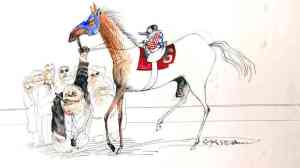 “The Kentucky Derby is Decadent and Depraved” is a significant benchmark for a number of reasons. Thompson was still finding his way in the “New Journalism” movement of the time, and after it was published it became the first of his pieces referred to as Gonzo–a moniker that was and will be forever synonymous with his revolutionary work. It also marked the beginning of a lifelong creative partnership between Thompson and artist Ralph Steadman. But it also provided a bit of social commentary about what it meant to interact with the “whisky gentry” of the South nearly half a century ago, and you can’t help but notice how little has changed since.
“The Kentucky Derby is Decadent and Depraved” is a significant benchmark for a number of reasons. Thompson was still finding his way in the “New Journalism” movement of the time, and after it was published it became the first of his pieces referred to as Gonzo–a moniker that was and will be forever synonymous with his revolutionary work. It also marked the beginning of a lifelong creative partnership between Thompson and artist Ralph Steadman. But it also provided a bit of social commentary about what it meant to interact with the “whisky gentry” of the South nearly half a century ago, and you can’t help but notice how little has changed since.
Personally, I’m connected to this piece in two ways. At this year’s South By Southwest festival in Austin, I caught the documentary “For No Good Reason,” a film about Steadman’s art and relationship with Thompson (Johnny Depp features prominently as well). It’s a great picture for Thompson/Gonzo fans, and the beginning of the Steadman-Thompson partnership at the time of the 1970 Kentucky Derby is featured prominently. The other personal connection is to Michael MacCambridge, contributor to the Grantland website who annotated “The Kentucky Derby is Decadent and Depraved” for the site–and taught me sports journalism at Washington University in St. Louis. Maybe he wouldn’t want me bragging about that, but it happened all the same.
Enough about me. The Kentucky Derby happens later this afternoon. Before then, do yourself a favor and take a few minutes to read the Director’s Cut version of “The Kentucky Derby is Decadent and Depraved” over at Grantland (language warning). And resist the urge to Mace everyone you see today.
–Chris @birdbrained
On The Job With Yadi
After St. Louis won Game 5 of the NLDS, the Cardinal Nation Twittersphere was obviously jubilant and busy. I happened upon a tweet by fellow Cardinal blogger Dennis Lawson that talked about the hug Adam Wainwright got from Yadier Molina at the conclusion of Wednesday night’s clincher and compared it to the hug Jason Motte got from Molina at the securing of the last out of the 2011 World Series. After a quick exchange, Dennis remarked “Seriously, I want to celebrate the end of a work day with a Yadi hug.”
celebrate the end of a work day with a Yadi hug.”
It’s a funny mental picture, depending on your job. And it got me thinking: that would actually make a great “This is SportsCenter” commercial.
You’ve seen these spots advertising ESPN’s flagship news and highlights show; athletes or mascots or pop culture luminaries interact with SportsCenter anchors in the offices or on the set of the network’s headquarters and awkward hilarity ensues. Albert Pujols as “The Machine,” somewhat vanilla football commentator John Clayton as a metal head, and this misunderstanding in the lunch line are a few of my favorites. Proposing ideas for these commercials is certainly nothing new, but I’m going to give it a whirl. I’m emulating the “This is SportsCenter” model so of course the settings and cast will follow suit.
Scene 1
SportsCenter anchor John Anderson gets out of his car to head into work at the start of the day. He is met by Yadier Molina in full uniform and gear (but carrying his mask), who walks Anderson into the building like he would walk from the bullpen to the dugout with that day’s starting pitcher. While they’re walking Molina says “OK John, you have a tough day today: full NFL schedule, MLB playoffs, hockey highlights. Here (hands Anderson a sheet of paper) is your list of catch phrases; stick to the game plan and we should get through OK.” Anderson agrees with everything Molina says.
Scene 2
Cut to the lunchroom, and anchor Scott Van Pelt is looking in the fridge. He says “Hmm, I wonder what John brought me for lunch today…” Suddenly the door is slammed shut, almost smashing his hand. Van Pelt straightens and turns; Molina is standing there (full uniform and gear, but again no mask) slowly shaking his head and says, firmly, “NO STEALING.” Van Pelt mumbles an apology and sulks out of the room while Molina looks at him disapprovingly.
Scene 3
Cut to the SportsCenter studio, showing Anderson in the middle of anchoring but from over his shoulder so the ESPN cameras and teleprompters are visible too. Among the cameras is Molina in his crouch (full gear with mask). As Anderson is setting up a highlight, Molina puts down a two fingers sign; Anderson pauses for an instant to glance at the catch phrase sheet Molina gave him earlier and smoothly delivers catch phrase #2. 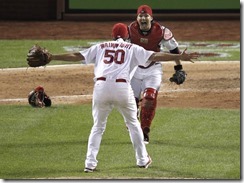
Scene 4
Anderson, obviously tired and a little disheveled after a long day, punches out at a time clock and, turning, raises his hands in relief and joy. The camera then pans back to show Molina doing the same thing and running toward Anderson; they hug and jump and yell as if they just won the World Series while “This is SportsCenter” appears on the screen.
I’m not sure if all of that could be squeezed into 30 seconds; maybe the lunchroom scene would have to be a short follow-up commercial. But I think it works. Because let’s face it…we’d all be a little happier at our jobs if we knew even the toughest day might end with a hug from Yadi.
–CCR










